- Received November 30, -0001
- Accepted November 30, -0001
- Publication May 27, 2020
- Visibility 20 Views
- Downloads 0 Downloads
- DOI 10.18231/j.ijodr.2020.014
-
CrossMark
- Citation
Lingual orthodontics - A review
- Author Details:
-
Vikranth Shetty *
-
Shilpa Vikranth Shetty
-
Sagar Sarje
-
Ragni Tandon
-
Kamlesh Singh
Introduction
The research in orthodontics has led to introduction of new fixed appliance techniques which can treat many occlusions. The acceptance for orthodontic treatment is increased and esthetic impairement of labial fixed appliances has led to development of lingual appliance.
[1] The treatment with lingual appliance had an impairement with an injury to the intraoral tissues and inadequate space for the tongue. The percentage of patients content with lingual technique was 99%.Also 87% of patients would recommend the lingual appliance to friends and relatives. [2] The growth in lingual orthodontics began in the era of 1975.The lingual technique is increasingly accepted by adults. [3] Dr. Craven Kurz used brackets on the lingual surface for the first time and a significant contribution to the lingual orthodontics was made. This appliance consists of specially designed brackets to be placed on lingual surface of teeth.[4]
Lingual History
The Kinja Fujita was the first to propagate lingual technique using mushroom shaped arch wire. He began working on lingual technique in 1968 and then went on for Research in 1971and finally published the concepts of Fujita Bracket in 1978. [5], [6]
1889-Lingual Removable Arch by John Farrar
1918-Lingual Arch was developed by John Mershon
1922 –labial and lingual arches presentation with finger springs developed by Mershon
1942 -.Development of labiolingual appliance by Dr.Oren Oliver
Labio-loop-lingual appliance developed by Dr William Wilson
1975-Dr Craven Kurz who made an important contribution to orthodontics by using a lingual bonded edgewise appliance for the first time. The Kurz lingual bracket evolved further as Ormco 7th Generation Bracket. [5]
1979- Mushroom shaped arch wires and lingual bracket design was developed by Dr Kinya fujita of Kanagawa Dental University, Japan [6]
Difficulties encountered with lingual technique
Tongue irritation and speech difficulties
Gingival impingement and occlusal interferences
Control over the appliance
Adaptation over the base pad and appliance placement and bonding
Wire placements
Attatchments and ligations
Evolution of lingual brackets[7]
First generation (1976)
Bite Plane and Rounded Margins
Large Brackets
Advantages
Bite opening anteriorly, facilitating mesiodistal movement or expansion. It also causes extrusion of molars and intrusion of incisors.
Second Generation(1980)
Addition of hooks on canine brackets
Third Generation (1981)
There was addition of hook to all brackets
An intraoral hook was added on first molar tube
Second molar had terminal sheath without hook
Fourth Generation (1982-1984)
Brackets were low profile
There was option for the hooks
Fifth Generation (1985-86)
Bite Plane Pronounced
Torque increased on Maxillary Anteriors
Molar brackets with accessory tubes for transpalatal arch
Sixth Generation (1987-90)
Elongation of hooks was done
An option for attatchment of TPA was created
Hinge cap tube for second molar
Seventh Generation (1990-present)
Rhomboid bite Plane
Advantages of lingual orthodontics
Preferred by adults and increased demand [8]
Esthetic and absolutely invisible invisible Appliance [9], [10]
No damage to the labial enamel surface
No labial enamel decalcification
Bio-mechanically efficient during retraction
Easier evaluation of individual tooth malposition and treatment progress
Easier appreciation of soft tissue response
Disadvantages of lingual appliances
Indirect Vision hampered accurate bracket placement
Occlusal interferences caused frequent bond failures and at times restricted tooth development
Speech Distortion
The sharp edge lacerates the tongue
Gingival irritation due to plaque accumulation
Increased chair side time due to difficulty in insertion and ligation of arch wire
Indication for lingual appliances
Intrusion of Anterior teeth
Expansion of the Maxillary Arch
Repositioning of the mandible with orthodontic tooth movements
Distalisation of maxillary molars
Treatment of cases with case complicated with an existant tongue thrust habit
Ideal Cases [11]
Low Angle Deep bite
Class II Division 2
Class 2 upper arch extraction cases
Class I minor crowding [11]
Diastema Closure
Pre-Prosthetic Tooth movement and Surgical cases
Class III Cases [12]
Difficult Cases
Bicuspid extractions
Posterior Crossbite
High Angle
Open bite
Anchorage considerations in lingual orthodontics
In non Growing Adults anchorage is critical
In Mutilated cases the anchorage is critical
Poor periodontal support and bone loss
Aesthetic demand in these category of patients is very high
Introduction of bite plane induces loss of occlusion and intercuspation which results in loss of anchorage.
Bracket Systems
Various Lingual brackets have been developed from the past 25 years and also modifications have been done for patient control, Precise tooth positioning and mechanical efficiency
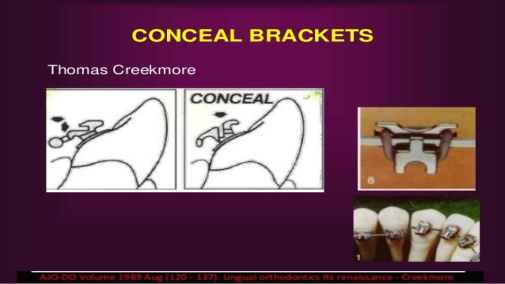
The. Arch wire insertion and removal with occlusal approach is better than arch wire insertion with lingually opening slots.[13] The opening of the arch wire surface is towards occlusal rather than towards lingual aspect
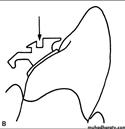
Fujita Lingual Bracket had a slot that opens towards occlusal. Into the slot the lock pin was inserted mesiodistally into a groove in the slot to hold the arch wire along with elastomers and ligatures. Modifications were made to the brackets and the opening remains occlusal. [14]

Development by Dr.Scuzzo and Dr.Takemoto (Sold by Ormco)
The acceptance for the orthodontic treatment is improved greatly with these brackets. The tolerability of the appliance has greatly improved and minimum speech disturbance.
The less complex cases were treated by 2D brackets of forestadent and 3D brackets for more complex cases. These brackets are hardly noticeable for the patient and low profile and manufactured by Forestadent
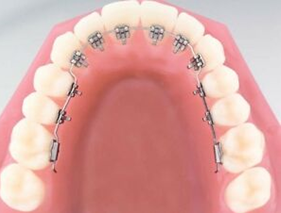
It is the old generation lingual bracket manufactured by American orthodontics. This bracket has poor rotation control without the use of auxillary. A Vertical slot has been incorporated to attatch an uprighting spring to adjust for the inadequate control caused by a slot that is too short.
Philippe self ligating lingual bracket
Massimo Ronchin in 1994 developed a self ligating lingual bracket which was based on the begg technique.[13] The same company had also developed the Phillipe Self Ligating Lingual Bracket which could not control torque but was useful for alignment and leveling. As there is no slots they can be directly bonded to the lingual tooth surface. The first order and second order movements can be anticipated in these type of brackets. A three wing bracket for the attatchment of intermaxillary elastics and application of 3rd order movements and a narrow single wing bracket for lower incisors, [15]
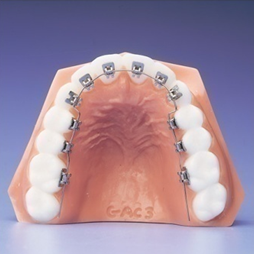
The best in controlling rotations since it is twin with two actual contact points between the bracket and wire. It is a labial unitek bracket adapted as a lingual one and not related to any special technique.
This is best in controlling rotations since there is two actual contact point contact between bracket and wire. It is adapted as a lingual one and not related to any special technique.

They are available in 0.022 inch slot. The brackets have rounded facial contours, large hooks which help in power chain and attatchment of springs, increase In the surface area of bracket to help in engaging double overtie. To improve bonding the bracket base is made large and horizontal slot enables easier expression of torque control.
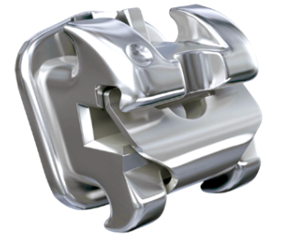
There is greater inter bracket distance in IN-Ovation bracket which helps in increased patient comfort. The bracket can be placed in the greatest portion of lingual fossa with better adaptation to the anatomical contours. The base pad can be easily bent to adapt to the complicated lingual shape of the cuspid due to the forked design built into the base. There is a self ligating clip incorporated so there is no necessity to change the ligature ties during appointments [16]
Braces(Incognito)
The main benefits of this bracket system are lower Profile with less patient discomfort and good finishing.[15] The manufacturing methods and design of this bracket system is different completely from the existing appliance. The technology of CAD-CAM appliance has made the process of bracket production and bracket positioning in one unit.
In earlier days due to poor training ,unavailability of bonding set up and no availability of preformed arch wires there was poor finish in lingual orthodontic treated cases. [17]
Bonding in lingual orthodontics [18]
A key factor for successful correction of a malocclusion with lingual orthodontics is precise and accurate positioning.
Customized lingual appliance set up service system
There exist anatomic discrepancies on the lingual surface of teeth and this is taken care by CLASS Technique. From the duplicate model of the patients ideal occlusion an ideal diagnostic set up is prepared .By using the template as a guide the placement of brackets is done in an ideal configuration. By using the composite adhesive as spacer the brackets are placed on the diagnostic set up before they are next transferred back to malocclusion cast. Once the transfer trays preparation is done an indirect bonding method is used to transfer the brackets clinically.
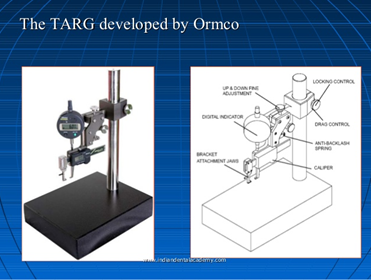
The Ormco Company has launched the TARG machine as an important tool to the laboratory technique in 1984. Each tooth has a specific Tip and Torque individually and also it could be placed at a specific distance from the incisal and occlusal surface of the teeth. Now a virtual set up base can be created bonded on the malocclusion set up with attatched resin modified base at the base of each bracket. In 1986 Didier Fillon developed a precise measuring device that was similar to the original TARG machine called as Electronic TARG [19]
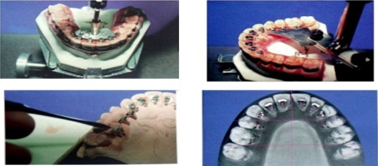
A new system was developed by Fillion in 1986.An important aspect was missing in this Original TARG that is the distance from the in the horizontal plane from the labial surface of the tooth to the slot of the lingual bracket. Also the different thickness between the teeth are compensated by adding a precise measuring device to the original TARG machine.
Slot Machine
Thomas Creekmore has designed the slot machine in such a way for placement of both conventional and lingual brackets directly on to the malocclusion model. Each tooth will be designated with specific tip and torque value. The bracket slot is oriented to the machine. The placement of brackets having either horizontal or vertical access arch wire slots is done by the slot machine. There is no requirement of a model tooth set up which is a major benefit. There is difficulty in managing lot of pieces of the slot machine which is a disadvantage.
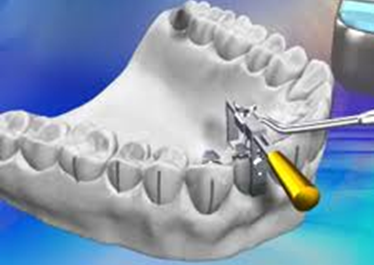
The Lingual Bracket Jig was developed by Geron and the lingual bracket jig helped in direct and indirect positioning of the brackets. In this set up there is a ruler, universal jig for the posterioe teeth and a set of six jigs for the maxillary anterior teeth. The Andrews labial bracket prescription is transferred to the lingual surface by means of jigs. The height of the bracket from the incisal edge is measured using an occlusal stop. Even direct bonding of bracket is done on the lingual surface by using Lingual Bracket Jig.
Transfer Optimized Positioning
(Top/Incognito I Braces system)
Incognito braces are commonly known as lingual braces. They are manufactured using the robotic technology where there is 100% customization of bends in the arch wires and even each bracket is made to confirm to individual surface of each teeth also more effective than aligners. They cabn be used to tret complex malocclusions like spacing, crowding, rotations. The contouring of the bracket base is much smoother and rounder with incognito braces. Dirk Wiechmann fabricated a lingual bracket that adapted to the scanned model20
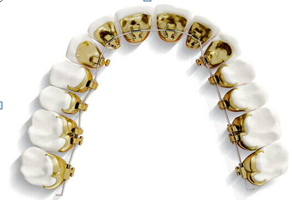
Korean indirect bonding set up (KIS)
Tae weon kim established the Korean society of lingual Orthodontics and found Model Checker, Bracket Positioner and CRC –Ready made Core trays which together form the Korean Indirect bonding set up System [20]
The Korean indirect bonding set up was developed by the Korean society of Lingual Orthodontics. Indirect bonding set up allows positioning of all brackets at once using a bracket positioning machine .A set up model is created and then it is checked for increased precision with a model guage.
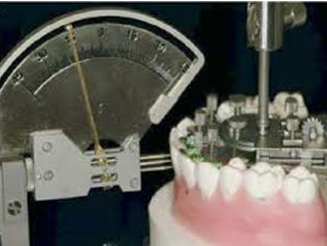
HIRO system
HIRO System does not require any special equipment like other systems .It was introduced by Toshiaki Hiro and later improved by Kyoto Takemoto and Giuseppe Scuzzo. The first set up in preparation of the set up model is sectioning of the teeth and aligning. The fabrication of arch form is done by bending a full sized rigid rectangular arch wire and positioning of brackets on it .Now the transfer trays are prepared individually and transferred from he set up.

Preparation of individual transfer trays is done by hard resin in the Convertible resin core system and here the tray and bracket were held together by an elastomeric ligature. Then there is accurate repositioning of the brackets within the resin core system and trays can be reused in case of debonding of brackets. The first bonding session with the unitary trays is of long duration and then this technique would rely on the set up model.
Hybrid Core System
In this system there is mainly transfer of brackets. Matsuno developed the Hybrid Core System which has the favourable properties of silicone and composite resin in the construction of its indirect transfer tray. The bracket is covered by silicone and then by compsite resin during the construction of indirect transfer tray. By doing this combination there is stable positioning of the transfer tray within the mouth and removal of the silicone component from the bonded bracket made easier.
Simplified Technique
In the Simplified technique the STB brackets are placed directly on the lingual surface of teeth by using a bracket placement plier and simple tweezers. The Placement of brackets are done by keeping a distance of 1.5 to 2mm from the incisal edge of anterior teeth. The STB brackets were developed by Giuseppe Scuzzo along with Kyoto Takemoto from Japan fabricated a lingual straight wire bracket and technique known as STB [21]

Orapix System
The recent lingual orthodontic laboratory system is the Orapix system. The scanner scans the patient model to a three dimensional data file. The Prepared data file along with the 3-txer software package is sent to the orthodontist via the internet.The orthodontist will create a virtual set up on the computer by using the 3D model.In Once the clinician receives all the details about the patient on the computer screen the orthodontist can decide on the amount of angulation and torque to be given. once this step is done the information is sent back to the laboratory through the internet.
Retention protocol in lingual orthodontics
Fixed Bonded retainer
Begg wrap around retainer
Hawley retainer
Conclusion
The future of orthodontics is undergoing rapid changes. The demand fot aesthetics and as the awareness of lingual orthodontics is being spread everywhere. There will be lot of patients opting for Lingual orthodontics in future.
Sources of Funding
None.
Conflict of Interest
None.
References
- B Meier, Weimer. KB Miethke RR Invisalign patient Profiling. J Oro Fac ortho 2003. [Google Scholar]
- U Freitz, P Diedrich. Weichmann-Lingual Technique- Patients characteristics motivation and acceptance.Interpretation of a retrospective survey. J Oro Fac 2002. [Google Scholar]
- Profit. Profit Treatment for Adults. In:Profitt WR Contemporary Orthodontics. 2000. [Google Scholar]
- A Gupta, A Ansari, Krishna Nayak, U S Agarwal, A Savana, K A. Lingual Approach of Orthodontic Treatment :A Case Report. Int JAdv Health 2014. [Google Scholar]
- K Fujita. New Orthodontic Treatment with Lingual bracket and mushroom arch wire appliance. Am J Orthod 1979. [Google Scholar]
- K Fujita. Multilingual Bracket and mushroom arch wire technique:a clinical report. Am J 1982. [Google Scholar]
- Fiona Grist. Basic Guide to Orthodontic dental Nursing. 2010. [Google Scholar]
- Fiona Grist, Rdn. RDN Fixed aplliances –Indirect Bonding and Lingual Orthodontics. 2010. [Google Scholar]
- A Gupta, Thukral. Lingual Orthodontics an esthetic consideration. J Adv Med Dent 2015. [Google Scholar]
- Dirk Wiechmann. Lingual orthodontics (part 1): Laboratory procedure. J Orofacial Orthop 1999. [Google Scholar]
- R Prabhakar, N R Vikram, R Saravanan, M K Karthikeyan, R Rajesh. . Lingual Orthod IJMH 2012. [Google Scholar]
- A Gupta, V S Kohli, P V Hazarey. . Lingual Orthod Rev Part I J Ind Orthod 2005. [Google Scholar]
- Thomas Creekmore. Lingual orthodontics—Its renaissance. Am J Orthod Dentofac Orthop 1989. [Google Scholar]
- Ryoon Ki Hong, Hee wook Sohn. update on the fujita Lingual Brackets. J Clin Orthod 1999. [Google Scholar]
- M Ronchin. Resolving a Class II malocclusion with molar distalisation. Pract Perio Aesthet Dent 1994. [Google Scholar]
- Navarro. Development of the In Ovation L Bracket From GAC. Lingual News 2006. [Google Scholar]
- R Romano, Ontario, Decker. Lingual Orthodontics. 1998. [Google Scholar]
- Laura Buso-Frost, Didier Fillion. An Overall View of the Different Laboratory Procedures Used in Conjunction with Lingual Orthodontics. Semin Orthod 2006. [Google Scholar]
- D Fillon. Improving Patient comfort with lingual brackets . J Clin Orthod 1997. [Google Scholar]
- Pablo Echarri. Lingual Orthodontics: Patient Selection and Diagnostic Considerations. Seminars in Orthodontics 2006. [Google Scholar] [Crossref]
- G Scuzzo, K Takemoto. Invisible Orthodontics.Current concepts and solutions in lingual orthodontics. 2003. [Google Scholar]
- Introduction
- Lingual History
- Labio-loop-lingual appliance developed by Dr William Wilson
- Difficulties encountered with lingual technique
- Evolution of lingual brackets[7]
- Advantages
- Second Generation(1980)
- Third Generation (1981)
- Fourth Generation (1982-1984)
- Fifth Generation (1985-86)
- Sixth Generation (1987-90)
- Seventh Generation (1990-present)
- Advantages of lingual orthodontics
- Disadvantages of lingual appliances
- Indication for lingual appliances
- Ideal Cases [11]
- Difficult Cases
- Anchorage considerations in lingual orthodontics
- Bracket Systems
- Philippe self ligating lingual bracket
- Braces(Incognito)
- Bonding in lingual orthodontics [18]
- Customized lingual appliance set up service system
- Slot Machine
- Transfer Optimized Positioning
- (Top/Incognito I Braces system)
- HIRO system
- Hybrid Core System
- Simplified Technique
- Orapix System
- Retention protocol in lingual orthodontics
- Conclusion
- Sources of Funding
- Conflict of Interest
